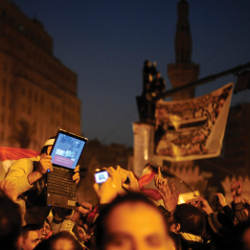
The 2011 Egyptian revolution, which drew inspiration from protests in Tunisia and led to widespread anti-government uprisings throughout North Africa and the Middle East, began with protests on January 25, 2011, culminating February 11, 2011 with the resignation of President Hosni Mubarak.1 The protests and the revolution and their reflection in social media garnered enormous worldwide media attention. While some analysts said social media like Twitter and Facebook were not critical to the revolution,4 others, including a number of activists on the scene, credit social media with helping the movement achieve critical mass.2,3 Whatever role Twitter and other social media played, there is no question that the protesters, as well as media and journalists, made extensive use of social networking sites, tweeting and texting on the protests, with the messages read and commented on by people around the world. In this sense, the stream of tweets represents an enormous, unfiltered history of events from a multitude of perspectives, as well as an opportunity to characterize the revolution’s events and emotions.
Key Insights
- Scalable analytics helps make sense of the influence on and outcome of large-scale social and political events, as they unfold.
- Advanced algorithms for sentiment and response analysis help differentiate behavior patterns of groups within different communities.
- Twitter discussion on the Egyptian revolution was much different from other Twitter discussions in terms of who was tweeting and what was said.
We set out to weigh more than 800,000 tweets on topics related to the revolution so we could present our analysis here from three different perspectives:a First, how sentiment evolved in response to unfolding events; how the most influential tweeters and popular tweets shed light on the most influential Twitter users and what types of tweets reverberated most strongly; and how user sentiment and follower relationships relate in terms of dynamic social network characteristics and sentiment. Using these metrics, we compared Egypt-related topics during the revolution to other popular early-2011 trending topics (such as politics, sports, and entertainment) (see the sidebar “Pulse of a Revolution“).
Evolving Emotion
To get a sense of how Twitter activity reflected the events of the revolution, we selected six Egypt-related topics that trended at least three days during the period January 25February 11, 2011, where a trending topic was a subject identified by Twitter that notably increased how much it was discussed.5 We also selected topics that trended several times to see how conversations developed in response to the events of the revolution.
We collected thousands to hundreds of thousands of tweets for each day Egypt-related topics were trending and assessed the sentiment of daily tweets. We classified the sentiment for each tweet as positive, negative, or neutral based on a sentiment-analysis technique described by Zhang et al.6 As Twitter does not require users provide their geographical location, we were unable to isolate the tweets coming from within Egypt itself.
Figure 1a lists the volume of tweets per day, Figure 1b lists cumulative tweets, and Table 1 outlines some of the revolution’s major events, along with the number of tweets and the average sentiment for four Egypt-related Twitter topics. Note that we collected this data in real time in our lab for all trending topics available from Twitter.
The first day the topics trended coincided with the January 25 “Day of Rage” protest in Cairo’s Tahrir Square, with the Cairo topic showing mostly negative sentiment at the time. On January 27, the Egyptian government began limiting access to social media and the Internet within the country’s national network. Later, many of the tweets were likely tweeted from outside Egypt. Correspondingly, “egypt” alone trends on January 27, while “egypt,” “egyptians,” and “cairo” accounted for most of the traffic during the government-imposed Internet blackout. On January 29, Mubarak fired his cabinet and installed Omar Suleiman as vice president, coinciding with a peak in the number of tweets on the topics of “egypt” and “cairo” and a peak in sentiment on “egyptians.” Immediately afterward, the sentiment value for most topics decreased, possibly due to decreased interest outside Egypt or the realization that Mubarak would not willingly step aside as president. The Egyptian government ended its blockade of Internet traffic February 2, coinciding with a significant spike in number of tweets and negative sentiment on the topic of Tahrir. While most Egypt-related topics stopped trending February 4, termed by the protesters the “Day of Departure,” the protests continued until Mubarak’s eventual resignation February 11.1 Meanwhile, tweets on “hosni_mubarak” became progressively more negative, so eventually, by February 6, 85% of the tweets on the topic were negative.
Influencers and Tweets
For a clearer view of Twitter users and tweets on Egypt, we looked at influential users and tweets on several Egypt-related topics, ranking their influence based on their follower relationships and on how tweets propagated through the follower network.
For each day the topics in Figure 1 were trending, we identified the top 10 most influential users worldwide. Table 2 lists the people and organizations that influenced these topics most, along with a breakdown of influential users in Figure 2a. Many users at the top of these lists belonged to major news organizations, including Al Jazeera and CNN, though New York-based Egyptian journalist Mona Eltahawyb established herself as a trusted source, with influence across a number of topics, and the most influential single user worldwide on Egyptian topics during the revolution.
We also analyzed the most influential tweets to characterize the simultaneous conversations that were taking place. We define influential tweets as those that were frequently “retweeted” or repeated by users to spread a tweet’s message.
We collected the most frequent retweets for each day the topics in Figure 1 were trending. In order to develop an understanding of what these influential tweets were saying, we sampled the 10 most influential and categorized them manually. We found most fit into three main categories: news (updates on major events), inspirational (human-interest stories), and humor. Table 3 lists popular tweets from each category, and Figure 2 outlines the distribution of these “most popular” tweets.
Almost two-thirds of the most popular tweets on Egypt-related topics were news, communicating important updates on unfolding events, while inspirational and humor tweets each represented 15%20% of the popular tweets. The topic “egyptians” was the source of more than half of the inspirational tweets.
Not Another Super Bowl
To see how Egypt compared to other trending Twitter topics, we chose several related and unrelated topics that trended at the same time across several categories in Figure 3. We chose them by scanning the topics that trended during the same period and selecting those covering four categories—politics, entertainment, sports, and tech/business—to include other popular topics during the same period. For each one, we collected data on the network of follower relationships between users tweeting on a particular topic and the sentiment expressed in the tweets on the topic. We analyzed aspects of the data for both Egyptian and non-Egyptian topics to determine what characteristics of Twitter users and their tweets separated the Egyptian revolution from other Twitter topics (see Figure 4).
We found that while users tweeting on Egypt-related topics had more followers tweeting on the same topic, the clustering coefficient of the follower networks was lower. The clustering coefficient, or “fraction of transitive triples,” is defined in graph theory as the fraction of follower relationships with users in common forming a triangle; for example, if user A follows user B and user B follows (or is followed by) user C, how often does A follow C or vice versa? Follower networks for the Egyptian topics were essentially less “clique-ish,” forming fewer tight groups despite having a similar number of follower relationships. This fact suggests the users tweeting on Egypt-related topics came from several different social groups both inside and outside Egypt.
We also found users tweeted more on average on Egypt-related topics, though their tweets were much more likely to be retweets, or echoes of tweets by other, presumably more authoritative, users, and more likely to express negative sentiment. With so many tweets on Egypt-related topics expressed in negative terms, the average user sentiment for Egypt-related networks (number of positive tweets minus negative tweets) was negative, notably unlike the other categories we considered.
Conclusion
We took an in-depth look at the ways the Egyptian revolution, late January to early February 2011, was discussed and debated as they unfolded through Twitter. The discussion was marked by strong negative sentiment less cohesive than for other types of Twitter topics. Moreover, a significant portion of the discussion reflected broadcast news of ongoing events, with most influential users and tweets delivering news and a large proportion of messages as a way to repost this news for others within, as well as outside, Egypt.
For more on other popular Twitter topics, including sentiment analysis and influential users, see our Web site http://www.pulseofthetweeters.com.
Acknowledgments
This work is supported in part by National Science Foundation awards CCF-0621443, OCI-0724599, CCF-0833131, CNS-0830927, IIS-0905205, OCI-0956311, CCF-0938000, CCF-1043085, CCF-1029166, and OCI-1144061 and in part by U.S. Department of Energy grants DE-FC02-07ER25808, DE-FG02-08ER25848, DE-SC0001283, DE-SC0005309, DE-SC0005340, and DE-SC0007456.
Figures
 Figure 1. Tweet volume (a) and sentiment (b) per day for six topics related to the Egyptian revolution; tweet sentiment was measured in terms of “positive sentiment fraction,” or the fraction of tweets with positive sentiment.
Figure 1. Tweet volume (a) and sentiment (b) per day for six topics related to the Egyptian revolution; tweet sentiment was measured in terms of “positive sentiment fraction,” or the fraction of tweets with positive sentiment.
 Figure 2. Breakdown of the most influential users and most frequently retweeted tweets late January to early February 2011 worldwide; influential users in (a) represent 43% of the top 10 influencers for the days the Egyptian topics were trending.
Figure 2. Breakdown of the most influential users and most frequently retweeted tweets late January to early February 2011 worldwide; influential users in (a) represent 43% of the top 10 influencers for the days the Egyptian topics were trending.
 Figure 3. Twitter topics by category.
Figure 3. Twitter topics by category.
 Figure 4. Twitter networks covering Egypt compared with other Twitter topics.
Figure 4. Twitter networks covering Egypt compared with other Twitter topics.
Tables
 Table 1. Events during the revolution reflecting tweet volume compared with sentiment (per day and cumulatively); positive tweet fraction is the daily or cumulative number of tweets with positive sentiment divided by number of tweets with positive or negative sentiment. Only dates corresponding to major events are shown; for tweets and sentiment for each day the topics were trending, see
Table 1. Events during the revolution reflecting tweet volume compared with sentiment (per day and cumulatively); positive tweet fraction is the daily or cumulative number of tweets with positive sentiment divided by number of tweets with positive or negative sentiment. Only dates corresponding to major events are shown; for tweets and sentiment for each day the topics were trending, see
 Table 2. Top five most influential individuals and organizations tweeting on the Egyptian revolution, along with number of times each appeared in the daily list of top influencers.
Table 2. Top five most influential individuals and organizations tweeting on the Egyptian revolution, along with number of times each appeared in the daily list of top influencers.





Join the Discussion (0)
Become a Member or Sign In to Post a Comment